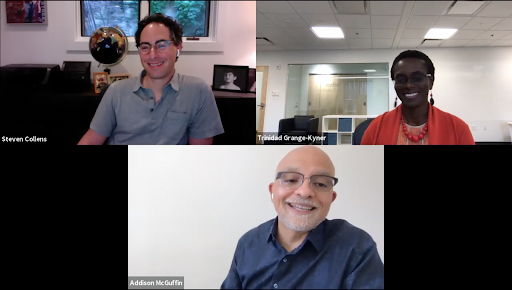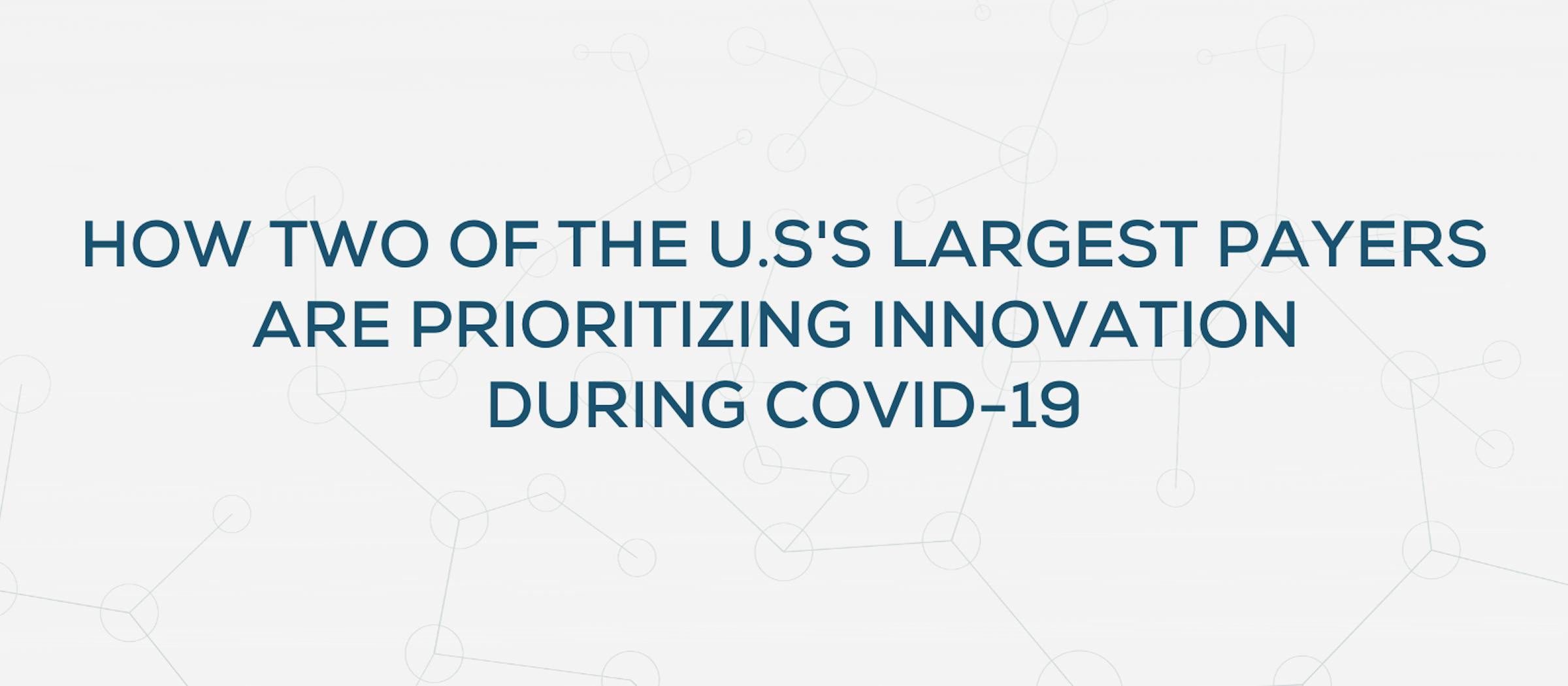How two of the U.S.’s largest payers are prioritizing innovation during COVID-19
Anthem, Inc. and Health Care Service Corporation share insights into their digital-first focus
How can industry innovators work together to build solutions that serve our healthcare system today, while preparing us for a stronger post-COVID-19 world?
Now more than ever, transformation and innovation are paramount and the solutions that emerge during this pandemic will reshape the industry as we know it. In a recent conversation with MATTER CEO Steven Collens, Health Care Service Corporation Vice President, Digital and Innovation Officer Addison McGuffin and Anthem Innovation Portfolio Leader Trinidad Grange-Kyner discussed how their respective organizations are prioritizing innovation during the pandemic and beyond, and what solutions they hope to uncover through the Pandemic Response Innovation Challenge.
You can watch the recording of the full conversation here.
Here are our key takeaways from the event. Responses have been edited slightly for length and clarity.
Innovation opportunities for ‘the new next’
Trinidad: “The COVID-19 pandemic has significantly highlighted the shortcomings and challenges of the healthcare system. Quite frankly, the opportunity that’s in front of us is to reshape healthcare with more predictive, proactive and personalized solutions — and those solutions need to address whole health. “At Anthem, we’re taking a platform approach to becoming a great partner in health. We’re relying on innovative solutions that we can quickly deploy to our members based on their emerging needs. We’re leveraging data analytics and emerging technology to deliver meaningful impact to people while the country continues to adapt to this new normal.”
Addison: “I’ve heard the phrase ‘new normal’ used quite often, but the phrase I like the best is ‘new next’. This is our new next, which means everything that we’re doing now, we’re going to be doing from now on. In fact, I think we’re going to be doing more of some of the things that we’re doing now, specifically when it comes down to how we engage the consumer on the services that we’re providing directly versus our traditional means.”
The opportunity that’s in front of us is to reshape healthcare with more predictive, proactive and personalized solutions — and those solutions need to address whole health. - Trinidad Grange-Kyner, Anthem
A stronger approach to collaboration
Trinidad: “When COVID-19 hit, we were already well on our way to becoming a digital first company, but it has certainly accelerated our innovation work. It pushed us to pursue even more partnerships and alliances so that we can expand our impact and connect parties within the healthcare industry. We want to be proactively anticipating and responding quickly to the needs of our consumers today, and, let’s be honest: for future pandemics as well.
“The question is: How do we make our healthcare system sustainable and resilient? Right now, every organization is effectively a healthcare organization. Everyone is considering the health factors that will help them keep their businesses open. They’re now thinking about things like the temperatures of employees — something they wouldn’t typically have bothered thinking about before. We need to capitalize on that awareness and recognize that there are lots of adjacent industries that we need to form stronger coalitions with.”
Addison: “I’ll add that one of the most important focus areas is also collaboration among ecosystem players. This experience has really forced people to operate outside of a pure competition model and move to more of a cooper-tition model. So many unique collaborations and configurations are now coming together to share like they’ve never done before.”
This experience has really forced people to operate outside of a pure competition model and move to more of a cooper-tition model.-Addison McGuffin, HCSC
Removing barriers to adoption — thoughtfully
Addison: “A lot of times, we can try to introduce a lot of innovation and it’s fantastic. But then the inertia of the system itself slows down or drags that innovation back. What’s happened during COVID-19 is that all of that innovation is being pushed forward at the same time. We have to figure out how to create a sustainable model around it — not just an episodic put-the-bandaid-on-it approach.”
Trinidad: “Without a doubt, we’ve seen a shift from the physical care setting to the virtual care setting, using digital tools as well. And these tools existed before, right? We already had them, but it was that inertia of the system that never allowed for them to be adopted. The pandemic has somewhat taken us past that hurdle.
“When something as dramatic as a pandemic comes along, it really sharpens your focus. So right now, we are very much focused on impact — and we are very conscious of a lot of the things that would trip us up within big organizations. We’re being very conscious of the problems we’re trying to solve through these collaborations: Can we validate this very quickly? What are the success metrics? Who is telling us that this is the problem that we need to solve in this particular way? If we create a use case that applies to one particular segment, how can we apply that more broadly to different segments?”

Steven Collens, Trinidad Grange-Kyner and Addison McGuffin in discussion during the live virtual event on August 27
Pandemic Response Innovation Challenge: Behavioral health track
Addison: “Right now we’re in this moment where it’s not only important to stay healthy, but also to understand the various dimensions of what that means. There’s the physical side which is very visible and pronounced — there are many factors that then go around maintaining that physical wellbeing during this time.
“But the pandemic has also brought to the surface this wave of behavioral health issues. Those issues were here before — the byproducts of social determinants of health and other conditions that people are challenged with on a daily basis. The pandemic has created a pressure cooker effect: It has expanded the need for us to look at conditions that are not only related to anxiety and depression, but that are also spurring other tangential or ancillary situations that we need to address.
“The question is: How do we create a system in which holistic health — both the physical and the behavioral — is the priority? We’ve got more than 40 percent of Americans reporting issues associated with behavioral health right now. So the question is, can we create end-to-end systemic solutions that drive not only awareness, but allow us to take action and help measure change and impact? Beyond that, how do we share that information? How does that become intelligence that we can then build capabilities around or support systems from a digital-first perspective?”
The question is: How do we create a system in which holistic health — both the physical and the behavioral — is the priority? - Addison McGuffin, HCSC
Pandemic Response Innovation Challenge: Data sandbox track
Trinidad: “We really value the innovation that comes out of startups. For track two of the challenge, we’re inviting the startup community to submit real solutions that can leverage the data within Anthem’s Digital Data Sandbox.
“A few years ago, we were able to create this Digital Data Sandbox which offers vetted users the ability to build and train algorithms, validate those solutions with our Anthem experts and deploy those solutions within our digital platform, which reaches millions of consumers. The Data Sandbox itself uses certified, but de-identified data. It contains more than 14 years of longitudinal data with more than 40 million unique lives in our commercial lines of business. We also recently refreshed the sandbox so that it has thousands of COVID-19 related diagnoses and more than 6 billion medical claims, 2 billion pharmacy claims and 6 million electronic health records.
“The result is one of the largest data repositories for data scientists to really play with, look at the solutions or models that they’re building and test them against this data sandbox. With this track, our goal was to keep the challenge really open: What can you solve in this pandemic world with the additional data that we’ve been able to provide?”
Dream challenge outcomes
Trinidad: “In our Data Sandbox, we have H1N1 and SARS data. The ultimate outcome for me would be if we could use that existing data, extrapolate it with the COVID-19 data and predict the next pandemic. Can we find patient zero before it becomes a global pandemic?”
Addison: “We have a lot of technology, like video conferencing, that we’ve all now gotten very good at using. I would love for us to think systemically about how particular capabilities connect to one another that then drive an outcome for the better. We’ve talked about artificial intelligence for the individual, but it would be great to have a companion that is sensing more than just maybe your biorhythmic information, but mood and other dynamics and then acting on your behalf. We’re at this leaping point where we’re getting used to our technology working with us and not just for us. I would love to see a systemic solution that integrates conditions that would give a person the ability to navigate their day based on integrating all these pieces of information.”



